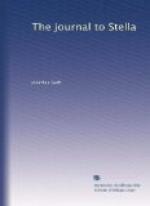Unfortunately he failed—partly no doubt from mistaken considerations of kindness, partly because he shrank from losing her affection—to take effective steps to put an end to Vanessa’s hopes. It would have been better if he had unhesitatingly made it clear to her that he could not return her passion, and that if she could not be satisfied with friendship the intimacy must cease. To quote Sir Henry Craik, “The friendship had begun in literary guidance: it was strengthened by flattery: it lived on a cold and almost stern repression, fed by confidences as to literary schemes, and by occasional literary compliments: but it never came to have a real hold over Swift’s heart.”
With 1716 we come to the alleged marriage with Stella. In 1752, seven years after Swift’s death, Lord Orrery, in his Remarks on Swift, said that Stella was “the concealed, but undoubted, wife of Dr. Swift. . . . If my informations are right, she was married to Dr. Swift in the year 1716, by Dr. Ashe, then Bishop of Clogher.” Ten years earlier, in 1742, in a letter to Deane Swift which I have not seen quoted before, Orrery spoke of the advantage of a wife to a man in his declining years; “nor had the Dean felt a blow, or wanted a companion, had he been married, or, in other words, had Stella lived.” What this means is not at all clear. In 1754, Dr. Delany, an old friend of Swift’s, wrote, in comment upon Orrery’s Remarks, “Your account of his marriage is, I am satisfied, true.” In 1789, George Monck Berkeley, in his Literary Relics, said that Swift and Stella were married by Dr. Ashe, “who himself related the circumstances to Bishop Berkeley, by whose relict the story was communicated to me.” Dr. Ashe cannot have told Bishop Berkeley by word of mouth, because Ashe died in 1717, the year after the supposed marriage, and Berkeley was then still abroad. But Berkeley was at the time tutor to Ashe’s son, and may therefore have been informed by letter, though it is difficult to believe that Ashe would write about such a secret so soon after the event. Thomas Sheridan, on information received from his father, Dr. Sheridan, Swift’s friend, accepted the story of the marriage in his book (1784), adding particulars which are of very doubtful authenticity; and Johnson, in his Lives of the Poets, says that Dr. Madden told him that Stella had related her “melancholy story” to Dr. Sheridan before her death. On the other hand, Dr. Lyon, Swift’s attendant in his later years, disbelieved the story of the marriage, which was, he said, “founded only on hearsay”; and Mrs. Dingley “laughed at it as an idle tale,” founded on suspicion.




